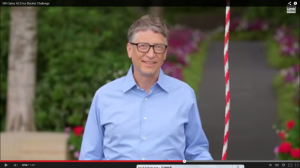Amyotrophic Lateral Sclerosis (ALS) is a disease which was rarely known by public before 2014. Patients diagnosed with this disease have relatively weaker muscle in early phase and gradually the symptoms develop to having difficulty in walking, swallowing, even breathing. The development of the Amyotrophic Lateral Sclerosis is progressive and irreversible, and there is not any effective treatment to cure this disease so far. Therefore, most ALS patients only have two to five years’ life expectancy after the diagnosis (ALS Association).
In the summer of 2014, a non-profit campaign called ALS (Amyotrophic Lateral Sclerosis) Ice Bucket Challenge went viral across all kinds of social media platforms such as Facebook, Twitter and Instagram. The ALS Ice Bucket Challenge mainly asks people to either dump a bucket of water with ice over the head or donate 100 dollars to the charity organization which fights Amyotrophic Lateral Sclerosis disease within 24 hours. After taking the challenge, the challenger has to upload the video onto at least one online platform and dare three other people to participate. The objective of this campaign is to raise people’s awareness towards this incurable disease and collect money for the study of the Amyotrophic Lateral Sclerosis.
Many celebrities participated in and disseminated the ALS Ice Bucket Challenge Campaign. Unlike other activities, this charitable fundraising activity not only attracted stars from the entertainment industry, but also some well-known businessmen and politicians. Up to now Bill Gates (http://www.youtube.com/watch?v=XS6ysDFTbLU), Mark Zuckerberg (http://www.youtube.com/watch?v=6TTpXKFBkjk), George W. Bush (http://www.youtube.com/watch?v=DepakUSDtQE), Tim Cook (http://www.youtube.com/watch?v=M_T1K7pFsI0), Jim Parsons (http://www.youtube.com/watch?v=l7l1p2vxTC8), Chris Pratt (http://www.youtube.com/watch?v=B_iCIg2oCCs) and many more had accepted the challenge and post their videos on the website. “The ALS Ice Bucket Challenge” had become one of the most popular hashtags on social media such as Twitter and Instragram. The celebrity effect and the innovative campaign format had significantly raised people’s awareness and triggered heated discussion on the internet.
Undoubtedly, the ALS Ice Bucket Challenge Campaign has achieved unbelievable success and it is more influential than most other non-profit campaigns. The ALS Association had raised 98.2 million dollars within a month, and the number of the donations collected last year during the same period was only 2.7 million. What is more, from the perspective of public awareness, the ALS Ice Bucket Campaign also outperformed other campaigns. Statistics show that before August 2014, only 1,662,842 people viewed the Amyotrophic Lateral Sclerosis’ page on Wikipedia, while this number increased to 2,717,754 views after the campaign was launched (Townsend, 2014).
The ALS Ice Bucket Challenge Campaign is a successful example of viral marketing. The main objective of viral marketing is “creating the potential exponential growth in the massage’s exposure and influence” (Wilson, 2000, p. 1). It is of great importance to generate effective unsolicited electronic referrals and raise customers’ awareness towards certain activity or product. From the perspective of psychology, customers may disseminate information either intentionally or unintentionally and several incentives can cause people to share the information. If there is strong social tie between the target audience and the information distributor, people are willing to pay more attention; if there is strong perceptual affinity between the target audience and the information distributor, recipients tend to have more interests to share information. Moreover, according to a study conducted by Woerdl and his colleagues (2008), message content determines whether information receivers have intention to distribute information to others. For instance, fun and intrigue information are better than boring information, and the message with high visibility seems to be shared more often.
The ALS Ice Bucket Challenge Campaign applies the principles mentioned above very well. First of all, it asked people to dare three of their friends to take the challenge, which created strong social tie. Since most participants were celebrities, there was strong perceptual affinity between them and their followers. As a consequence, the target audiences were more likely to share the campaign information on their social media sites. Last but not least, the form of the ALS Ice Bucket Challenge is different from other non-profit campaigns because video is more visible than words. People could easily get involved and the format of challenge is fun and interesting.
Even though the ALS Ice Bucket Challenge had created a miracle in the past summer, the influence of this campaign decreased gradually. Few people disseminated the information about this campaign in the past two months and audiences may even forget this campaign in the near future. A successful non-profit campaign should not only create a one-time buzz, but also create long-lasting influence so that it would be beneficial to the society.
Discussion questions:
1. How do you like the ALS Ice Bucket Challenge Campaign?
2. What do you think the ALS Association can do to maintain and increase the long-lasting influence of this campaign?
References:
ALS Association (2014). Quick facts about ALS. Retrieved from: http://www.alsa.org/news/media/quick-facts.html
Townsend, L. (2014, September 1). How much has the ice bucket challenge achieved? BBC News Magazine. Retrieved from: http://www.bbc.com/news/magazine-29013707
Wilson, R. F. (2000). The six simple principles of viral marketing. Web Marketing Today, 70(1), 232.
Woerdl, M., Papagiannidis, S., Bourlakis, M., & Li, F. (2008). Internet-Induced Marketing Techniques: Critical Factors in Viral Marketing Campaigns. Journal of Business Science and Applied Management, 3(1), 35-45.


15 Responses to The ALS Ice Bucket Challenge Campaign- a Successful Example of Viral Marketing